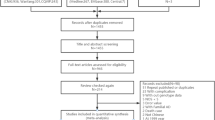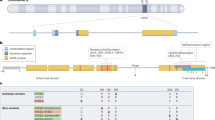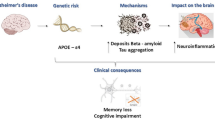Abstract
Case-control studies provide a powerful approach for detecting disease-susceptibility genes or assessing gene–environment interactions. We investigated the situation in which the gene being studied plays a role in several diseases, and the allele frequency among subjects free of the disease of interest consequently decreases with age as subjects die from other diseases. The logistic model is one approach frequently used for analyzing case-control data, but it cannot accommodate this dependence of genotype and age. Using a log-linear model, we therefore proposed a hierarchical procedure that could be used as a valid method for assessing interactions in such situations. We then applied this procedure to observed data on Alzheimer's disease and the apolipoprotein E gene in Japan. We were able to derive an appropriate inference on whether the interaction was a gene–age interaction or merely a bias due to death from other diseases.
Similar content being viewed by others
Log in or create a free account to read this content
Gain free access to this article, as well as selected content from this journal and more on nature.com
or
References
Akaike H (1970) Statistical predictor identification. Ann inst Stat Math 22:203–217
Asada T, Kariya T, Kinoshita T, Asaka A (1996) Apolipoprotein E allele in centenarians. Neurology 46: 1484–84
Asada T, Motonaga T, Yamagata Z, Uno M and Takahashi K (2000) Associations between retrospectively recalled napping behavior and later development of Alzheimer's Disease: Associations with APOE genotypes. Sleep 23:629–634
Borgaonkar DS, Schmidt LC, Martin SE, et al (1993) Linkage of late-onset Alzheimer's disease with apolipoprotein E type 4 on chromosome 19. Lancet 342:625
Corbo RM, Scacchi R (1999) Apolipoprotein E (ApoE) allele distribution in the world. Is APOE*4 a 'thrifty' allele? Ann Hum Genet 63:301–310
Corder EH, Saunders AM, Strittmatter WJ, et al (1993) Gene dose of apolipoprotein E type 4 allele and the risk of Alzheimer's disease in late onset families. Science 261:921–923
Corder EH, Saunders AM, Risch NJ, et al (1994) Protective effect of apolipoprotein E type 2 allele for late onset Alzheimer disease. Nat Genet 7:180–184
Farrer LA, Cupples LA, Haines JL, Hyman B, Kukull WA, Mayeux R, Myers RH, Pericak-Vance MA, Risch N, van Duijn CM (1997) Effects of age, sex, and ethnicity on the association between apolipoprotein E genotype and Alzheimer disease. A meta-analysis. APOE and Alzheimer Disease Meta Analysis Consortium. JAMA 278: 1349–1356
Gerdes LU, Jeune B, Ranberg KA, Nybo H, Vaupel JW (2000) Estimation of apolipoprotein e genotype-specific relative mortality risks from the distribution of genotypes in centenarians and middle-aged men: Apolipoprotein e gene is a "frailty gene", not a "longevity gene". Genet Epidemiol 19: 202–210
Health and Welfare Statistics Association (2002) Journal of Health and Welfare Statistics
Ou T, Yamakawa-Kobayashi K, Arinami T, Amemiya H, Fujiwara H, Kawata K, Saito M, Kikuchi S, Noguchi Y, Sugishita Y, Hamaguchi H (1998) Methylenetetrahydrofolate reductase and apolipoprotein E polymorphisms are independent risk factors for coronary heart disease in Japanese: a case-control study. Atherosclerosis 137: 23–28
Umbach DM, Weinberg CR (1997) Designing and analyzing case-control studies to exploit independence of genotype and exposure. Stat Med 16:1731–1743
Wilson PW, Myers RH, Larson MG, Ordovas JM, Wolf PA, Schaefer EJ (1994) Apolipoprotein E alleles, dyslipidemia, and coronary heart disease. The Framingham Offspring Study. JAMA 272:1666–1671
Acknowledgements
We thank Drs. Shuji Hashimoto, Takuhiro Yamaguchi, Jun Ohashi, and Seiichiro Yamamoto for their helpful discussions.
Author information
Authors and Affiliations
Corresponding author
Rights and permissions
About this article
Cite this article
Tanaka, N., Kinoshita, T., Asada, T. et al. Log-linear models for assessing gene–age interaction and their application to case-control studies of the apolipoprotein E (apoE) gene in Alzheimer's disease. J Hum Genet 48, 520–524 (2003). https://doi.org/10.1007/s10038-003-0069-4
Received:
Accepted:
Published:
Issue date:
DOI: https://doi.org/10.1007/s10038-003-0069-4
Keywords
This article is cited by
-
Gene-environment interplay in neurogenesis and neurodegeneration
Neurotoxicity Research (2004)



